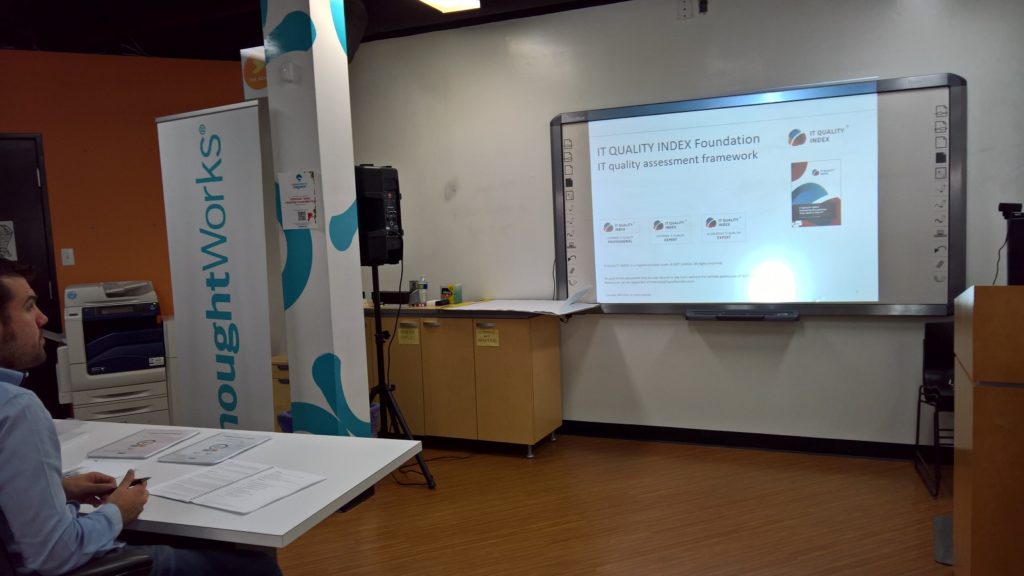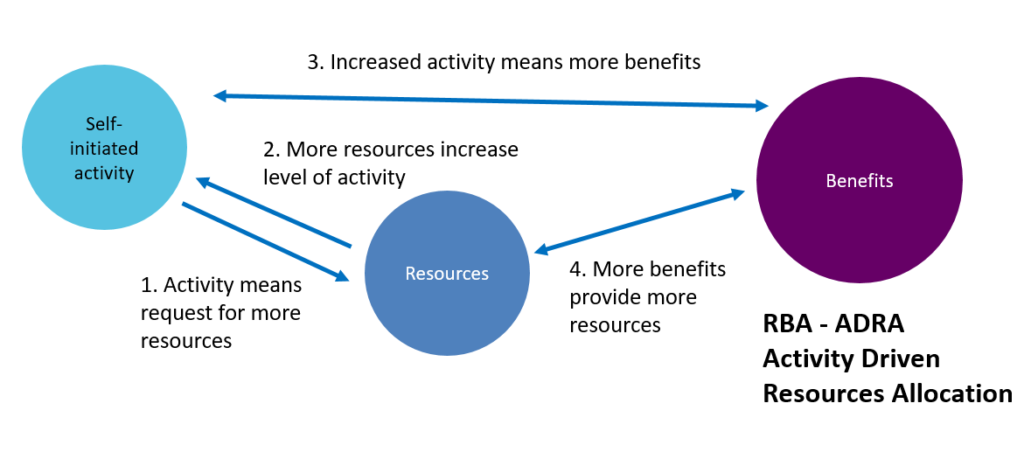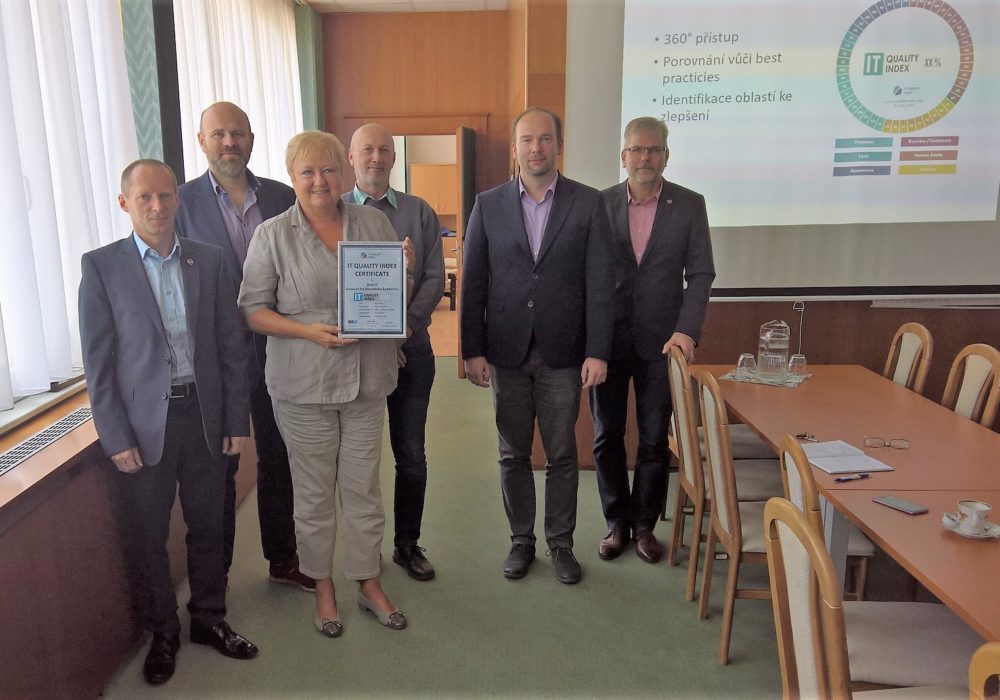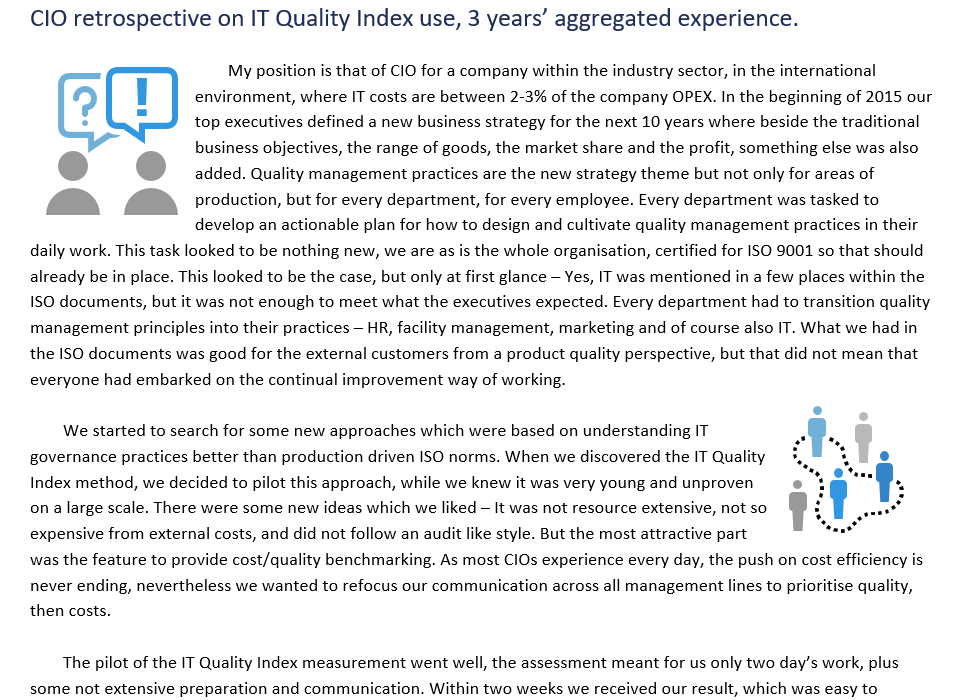Sorry, this entry is only available in Czech.
Journal
(Čeština) To je pouze začátek.
Case study IT Quality Index after 3 years
Why we use IT Quality Index and IT Quality Management System.
CIO retrospective on IT Quality Index use, 3 years’ aggregated experience.
Download in PDF
My position is that of CIO for a company within the industry sector, in the international environment, where IT costs are between 2-3% of the company OPEX. In the beginning of 2015 our top executives defined a new business strategy for the next 10 years where beside the traditional business objectives, the range of goods, the market share and the profit, something else was also added. Quality management practices are the new strategy theme but not only for areas of production, but for every department, for every employee. Every department was tasked to develop an actionable plan for how to design and cultivate quality management practices in their daily work. This task looked to be nothing new, we are as is the whole organisation, certified for ISO 9001 so that should already be in place. This looked to be the case, but only at first glance – Yes, IT was mentioned in a few places within the ISO documents, but it was not enough to meet what the executives expected. Every department had to transition quality management principles into their practices – HR, facility management, marketing and of course also IT. What we had in the ISO documents was good for the external customers from a product quality perspective, but that did not mean that everyone had embarked on the continual improvement way of working.
We started to search for some new approaches which were based on understanding IT governance practices better than production driven ISO norms. When we discovered the IT Quality Index method, we decided to pilot this approach, while we knew it was very young and unproven on a large scale. There were some new ideas which we liked – It was not resource extensive, not so expensive from external costs, and did not follow an audit like style. But the most attractive part was the feature to provide cost/quality benchmarking. As most CIOs experience every day, the push on cost efficiency is never ending, nevertheless we wanted to refocus our communication across all management lines to prioritise quality, then costs.
The pilot of the IT Quality Index measurement went well, the assessment meant for us only two day’s work, plus some not extensive preparation and communication. Within two weeks we received our result, which was easy to understand – A one figure result – Our IT Quality Index. We had no idea in the beginning how we compared to other similar IT departments, similar in size, segment, region. When we received the commented results we were really delighted. Our CFO wanted us to present our good results on the management meeting too so other department leads would see the score and the comparison with other IT departments. As I have previously had difficult experiences presenting audit findings and having to explain them over and over, I was not sure how interested others would be in our achievements but to my surprise they listened carefully and even confirmed their understanding – This is unlike any IT audit I have had to present in the past. They got the idea of quality measurement so easily. During that meeting management agreed to repeat the measurement every 2 years to keep eyes on it. There was also something unpredicted what happened during that meeting. The Facility Manager was asking whether they could use the very same approach to quantify the quality of their work, they wanted something similar for their practices. Another comment was from our Quality and Compliance Department Lead, she asked if we could report and show some statistics regarding the improvements made in IT over time periods and whether we could quantify the benefits of the improvements – Something that she was using in production quality management practices.
Based on the positive feedback from management we decided to establish a Quality Manager role in the IT organisation. In the past I was trying to get more staffing in IT, mainly for ITSM processes like SLM, change management, problem management. It was impossible to explain the benefits of the new positions as company executives disliked so many “managerial” positions in any organigram including IT. Yes, I was explaining that the role of process manager is not the same as the role of the team manager, nevertheless it did not help, no additional resources were ever approved. After our IT Quality Index measurement and management presentation I suggested to introduce a formal positon of an IT Quality Manager, who would be overarching many ITSM related tasks but would also be focused on self-improvement, visualisation and the reporting of what we did to work better and to support the new business strategy. The role of IT Quality Manager was approved by executives without any of the difficulties I remembered from the past. We staffed this role as contracted where we used external expert, who had a broad experience from more IT organisations and was also respected within our IT department. This position is not full time, we allocate there 25-35% FTE as there are some periods where we need to focus on priority projects and have less capacity to support IT quality management practices. The key part of the IT quality role is to challenge the way how we develop and use processes, how we communicate, how market IT, how we improve collaboration. It also ensures a means for us to verify if what we agreed on from a process and policy perspective is really something that we do in reality, as it makes no sense to document something that is just a statement on paper, which is ignored by others, or even forgotten, but which we have it stored as a documented rule of work.
IT improvements are now captured in an Quality Improvements Register, we process improvements in a visual form – We use a visual proportional board where every improvement is represented by a circle of a relative size showing the resources required to realise the improvement. We also recursively monitor resource consumption to avoid wasting too much time via quality administration practices. We started to report on management meetings the improvement volumes and the value delivered to our organisation. This was well accepted by management and we fit well into what others do too.
In 2017 we had our next assessment to confirm if our overall IT quality had improved or decreased. As we had some IT Quality Index target to achieve, we knew that some areas were not as improved as we intended them in 2015. Nevertheless, the re-measurement result was good, while the increase was only 2% and our initial ambition was a 3% increase. Results were again of interest to the executives, this time the presentation was even faster and other department leads confirmed the results as objective. We planned the next assessment for 2019 and we continue to track any improvement in IT. All the people in IT started to realise that reporting related to IT quality is in the bigger interest of everyone, rather than operations KPIs like average response time to requests or SLA fluctuations which happen all the time. We are also improving the visual part of our IT Quality Management System as this is helping to show everyone what we proactively do, not that we just wait for a ticket to be received and processed by IT.
Retrospectively I am very satisfied that we decided to pilot the IT Quality Index so early, we are now perceived in our organisation as a source of inspiration for quality management in other departments. There is also one thing to mention. When we speak to people outside of IT, we use the word quality much more often than in the past, and use the word costs a lot less. And this is in line with my philosophy – Quality has its price tag.
Consolidating some of my ideas and experience through the last three years, I believe that every IT department should start to introduce quality management principles from the perspective of self-improvement, rather than chasing SLAs and explaining who and why some deadline was missed. Quality is not a binary world where 1:59 hours to complete a request means a happy user and 2:01 an unhappy one. Quality means focusing on adaptations of routine practices, elimination of bad practices, and making everything visible outside of IT. When the business see our visual board and improvement statistics they see our visible effort to be better. This is what executives wanted to achieve, everyone should be trying to work better, this is the way people should encode in their mindsets. Quality is a workstyle.
Case study captured by Zdenek Kvapil, IT Quality Index architect, based on real world adopter of IT Quality Index since its very early development stage.
Want to learn more? IT Quality Index book, ISBN 9789401802420, is available here
Courses related to IT Quality Index are available here:
IT Quality Index USA Dallas
IT Quality Index trainings, Dallas, Addison, March 21-22 2018
IT Quality Index Foundation, Expert, Manager

The delivery of courses provides an invaluable opportunity to receive feedback from your audience as well as an opportunity to identify the areas with the most interest and that open up interesting discussions. In March we had the chance to introduce all of our IT Quality Index courses all together, from the IT Quality Foundation training, through Expert, to the newest course of IT Quality Manager.
The traditional approaches to quality management usually simplify quality to “Satisfied users” or “Meeting the users requirements – SLAs or KPIs”. It’s true that every IT department or IT service provider is also under pressure to reduce costs or increase efficiency, so why should anyone do more if we reach the certain levels of KPI, SLA, CSAT index? Quality management therefore means keeping numbers within their specified limits. Should we think about changing the way in which we work if that has the potential to negatively impact the figures we have reported for years? ‘We need continuity’ is what we typically hear from CIOs.
But the IT Quality Management System as described in a new course, IT Quality Manager, is built and designed in a different way.

Key differences and parts:
- IT is perceived as a complex system where individual parts constantly change and need to adopt to other system parts changes
- Change of one part of system may trigger need of change of other part of the system
- Quality starts with ability to detect fault part of the system component and this initiates corrective activity
- Quality improvement then means elimination of bad practices
- Quality improvement means search and adoption of better practices – right practices
- Quality improvement may be based on uncertain result of improvement as we can’t predict changes of other parts of system in the future
- We need to develop new techniques how to quantify benefits of improvements which could be then shown to executives in a figurative form, charts, reports – CVC, RBA, ADRA techniques
- IT Quality Management System needs to self-monitor resources consumed for improvements realization but also for improvements management. IT QMS needs to be recursively, continually improved as other parts of the system
- Role of IT Quality Manager defines new responsibilities as not defined yet in other best practices
- IT QMS is built around predefined Visual Board which makes improvements tangible and allows aggregation of knowledge over the time
Feedback from all three courses was good and provided confirmation about relevance of IT quality term as relevant agenda to the almost every IT department. Beside of well-known and established role of IT security manager we need to extend IT governance to cover also IT quality management practices, based on systems thinking. As many IT departments named and staffed security roles, the very same needs to happen with IT quality management.

Picture from the IT Quality Manager course: technique ADRA
Are you interested in learning more? You may download free overview of IT Quality Index here:
Or you also may order book here
And if you are experienced ITSM / IT governance consultant you may join growing trend and become first of Certified IT Quality Managers to help your client with introduction of IT quality management.
See dates and places
Kniha IT Quality Index vydána
Londýn, Gherkin, 14.11.2017, kniha IT Quality Index byla pokřtěna v ikonické budově, která tvoří součást panorama Londýna. Kniha je dostupná přes všechny významné prodejce knih.


